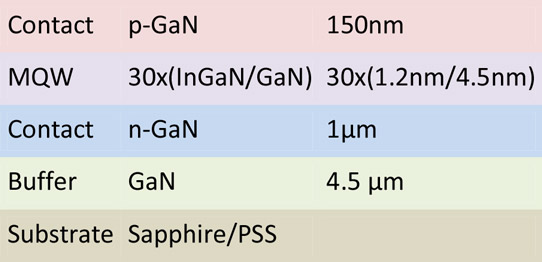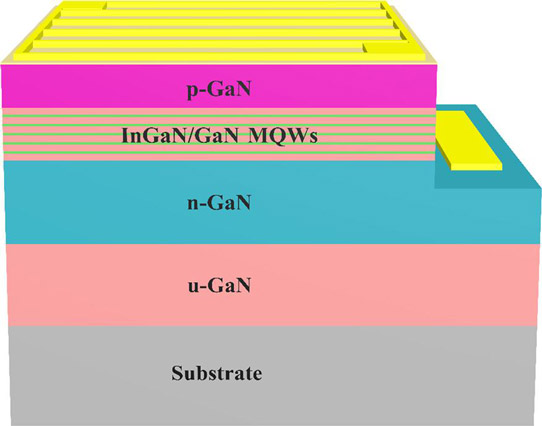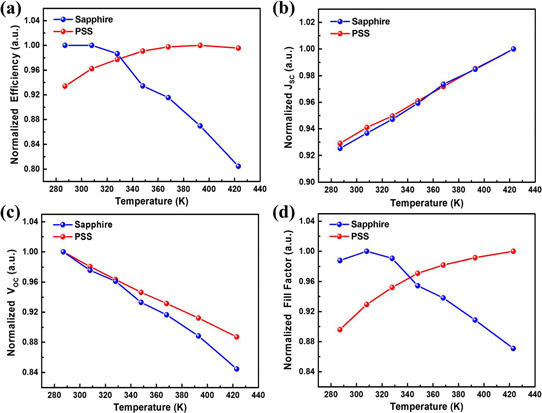- News
14 September 2016
Indium gallium nitride solar cells with positive temperature coefficient
Researchers in China have developed indium gallium nitride (InGaN) photovoltaic devices that increase in efficiency with temperature up to 423K [Zhaoying Chen et al, Appl. Phys. Lett., vol109, p062104, 2016]. "The positive efficiency temperature coefficient is very attractive for concentrator and high-temperature photovoltaic application," the researchers comment.
Although the wide bandgap of III-N semiconductors should lead to smaller dark current and hence a positive temperature dependence of efficiency on temperature, the lower crystal quality compared with narrower-bandgap materials, such as silicon, germanium and gallium arsenide, tends to cancel this expected effect.
The team based at Peking University and Collaborative Innovation Center of Quantum Matter used patterned sapphire substrates (PSSs) to improve material quality. "The adoption of the PSS improved the crystal quality of the epilayer, making the positive temperature coefficient of efficiency kept to 393K," the researchers comment.
The researchers further worked to create an optimized solar cell on PSS by improving the fabrication process. As a result, a positive temperature coefficient for the efficiency was maintained up to 423K. The characteristic room-temperature (~300K) solar cell parameters were 2.06% efficiency, 1.69V open circuit voltage (VOC), 2.32mA/cm2 short-circuit current density (JSC), and 52.5% fill factor (FF).
Of course, 2.06% is nowhere near the values obtained for silicon (up to 27%) or multi-junction devices that use III-V compound semiconductors (46%). The maximum reported efficiency for III-nitride solar cells is still only 3.4%. The restricted efficiency is related to the wider bandgap cutting off the majority of the solar spectrum as simulated by the AM1.5G standard. However, high-indium-content InGaN has a narrower bandgap with a lower limit of 0.64eV (InN).
InGaN material quality is compromised by the tendency to phase separation of InN and GaN. This results in defects, dislocations and non-uniformity. This is the main reason that III-nitride light-emitting and -absorbing devices use thin 'quantum wells' of InGaN rather than bulk material.
Even with the low reported efficiency, it is hoped that InGaN technology could find useful application as the top cell of multi-junction solar cells, particularly in concentrator/high-temperature conditions and with realization of a positive temperature coefficient for efficiency.
Multi-wafer metal-organic chemical vapor deposition (MOCVD) was used on (0001) sapphire with both normal and patterned substrates. The patterning consisted of a hexagonal array of conical protrusions.

Figure 1: Epitaxial structure.
The resulting epitaxial material (Figure 1) was formed into 1mmx1mm mesa-type solar cells with nickel/gold p- and titanium/aluminium/nickel/gold n-contacts (Figure 2). The p-contact was patterned in a grid with 30nm/150nm layers and transparent conducting electrodes with 5nm/5nm layers.

Figure 2: Schematic structure of InGaN/GaN MQW solar cell.
Photoluminescence and x-ray analysis suggested that the InGaN quantum wells contained ~30% indium fraction and were ~1.2nm thick. The GaN barriers were around 4.5nm. Using patterned sapphire substrates reduced edge-type dislocation densities to 1.54x108/cm2, compared with 4.07x108/cm2 for plain sapphire. By contrast, screw-type dislocations increased slightly with patterning to 1.58x108/cm2, compared with 1.34x108/cm2 on plain sapphire.
Table 1: Summary of solar cell performance of samples on sapphire and PSS.
| Substrate | VOC | JSC | FF | Efficiency |
| PSS | 2.01V | 0.97mA/cm2 | 59.4% | 1.16% |
| Sapphire | 2.06V | 0.71mA/cm2 | 64.4% | 0.94% |
Patterning improved the photovoltaic efficiency by 23.4% (Table 1). The researchers attribute this to the decrease in non-radiative recombination at dislocations, the resulting longer minority carrier lifetime increasing extraction into the photocurrent, and enhanced light absorption by the patterned sapphire texture.
The cells on patterned sapphire also showed increased efficiency with increased temperature up to 393K (Figure 3). By contrast, the device on plain sapphire showed a rapid decrease in efficiency.

Figure 3: Normalized temperature-dependent conversion efficiency (a), short-circuit current density (b), open-circuit voltage (c) and fill factor (d) for solar cells on PSS and sapphire.
The short-circuit current increased with temperature at almost the same rate in both devices. The team relates this to the narrowing of the InGaN bandgap with temperature, resulting in the cell being able to convert longer-wavelength photons. The narrower bandgap also reduces the open-circuit voltage, but on plain sapphire the voltage is further degraded by dark current from non-radiative recombination.
InGaN solar cells InGaN MOCVD Sapphire substrates
http://dx.doi.org/10.1063/1.4960765
The author Mike Cooke is a freelance technology journalist who has worked in the semiconductor and advanced technology sectors since 1997.


